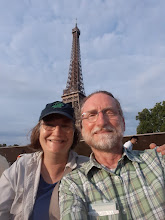Peeling an Onion, Part III
Once we made the decision to adopt, the next big discussion was domestic versus international adoption. Our situation was circumscribed by our desire for a large sibling group, which luckily narrowed our options. Three of the major issues in our decision were 1)the length of time until the adoption is finalized, 2) the future siutation of contact with the birth family, and 3) the subsidization of medical costs after the adoption.When we were adopting in Illinois, adoptions were not truly finalized until six months after the parents received custody of the children. International adoptions, on the other hand, are finalized in the foreign country before you travel home. I was concerned about the impact on bonding if we had to wait six months for the adoption to be final.
Secondly, many adoptions in the U.S. are now required to be "open," meaning that the child maintains some type of contact with the birth family. This can vary from letters once a year to personal visits on a regular basis. International adoptions have traditionally been closed, due to the physical distance, adoption law in most countries, and the circumstances surrounding the child's availability for adoption (e.g., abandonment). Jonathan and I know how much time it takes to keep up with our extended family, and the thought of adding a number of other families to this circle was daunting. Considering that children in sibling groups often have different fathers, the exponential nature of birth family contact seemed more overwhelming than we wanted to handle. (Interestingly, we have heard more recently that some international adoptions are becoming open. In almost all cases of adoption, birth parents are still living.)
If we adopted a sibling group in the U.S. through DCFS, the children's health care would be covered by Medicaid until they reached eighteen years of age. Even with good private health insurance, using Medicaid for a large family for many years would be a huge monetary savings. Many adoptees require more extensive medical care and therapy than the average child, which adds to their health care costs.
Many adoptive parents have never traveled internationally, and the prospect of the trip abroad is stressful for them. Agencies counter these fears by offering a wide range of services to help you, mostly at a very high cost. Jonathan and I had the advantage of extensive international experience in our backgrounds, and we actually viewed many of these services as intrusive. (Later, while we stayed in Kyiv and Kirovohrad, Masha worked faster on our legal issues because she could leave us unattended.)
We also hit a blank wall with DCFS in Illinois. There are very few large sibling groups available for adoption in Illinois, but we had heard that many such groups are available in Texas and California. These children usually speak Spanish, and since Jonathan grew up as a missionary kid in Guatemala and Mexico, he is totally fluent in Spanish. But we were required to work through DCFS in Illinois, and their mandate is to get Illinois children adopted. We received very little assistance from them, even in the initial information-gathering stage and before we had signed on. It became clear that for a domestic adoption of a sibling group, we'd have to find the group ourselves, work through another state where we weren't residents, and then hope that DCFS in Illinois would process the adoption in a timely manner (even though they felt no mandate to do so).
I won't go into how Jonathan and I weighed all these options. The final summation of our discussion: while adopting a U.S. sibiling group had some positive aspects, it was much easier for us to adopt internationally, both from a legal angle and also due to our background experience. In addition, we gained the advantage of a closed adoption that finalized quickly.


0 Comments:
Post a Comment
<< Home